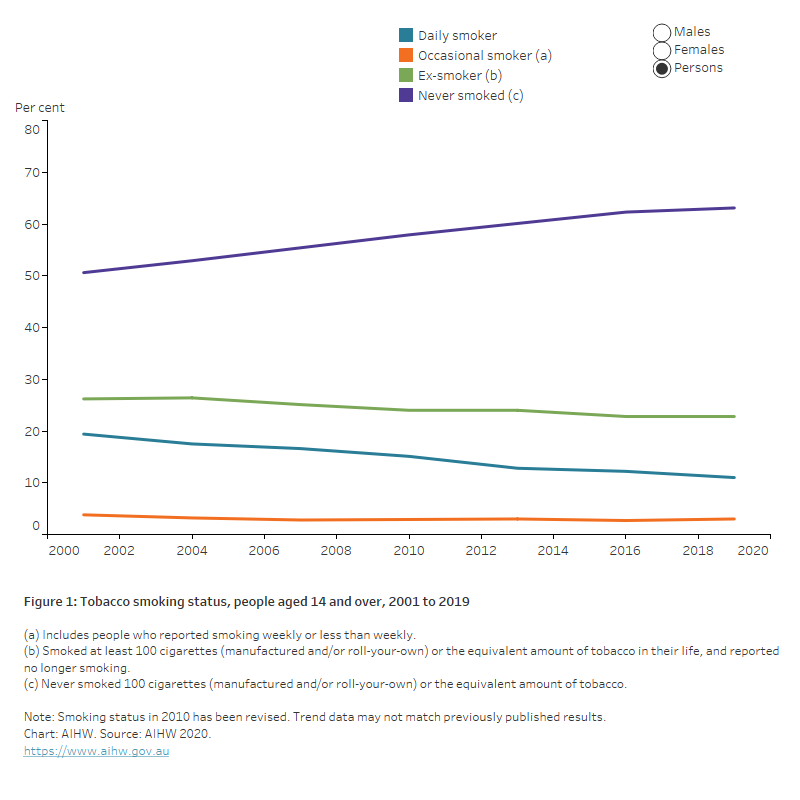Smoking
In 2019, based on results from the National Drug Strategy Household Survey:
- 11.0% of people aged 14 and over smoked daily
- males were 1.2 times as likely to smoke daily as females, after controlling for age
- between 2001 and 2019, the proportion of males aged 14 and over who smoked daily decreased by 42% and females by 45% (Figure 1).
- men aged 40–49 had the highest proportion of current daily smokers (18.4%), while the highest proportion among women were aged 50–59 (15.2%).
- daily smoking rates among males and females aged 15–24 decreased between 2001 and 2019 by 59% and 69%, respectively (AIHW 2020).
Tobacco smoking is the leading cause of preventable disease and death in Australia today (AIHW 2021). While the exact mechanism for how smoking impacts diabetes risk is unclear, research has shown that smoking increases insulin resistance and is associated with an increased risk of type 2 diabetes in men and women (Chang 2012). Prenatal smoking is also associated with an increased risk of gestational diabetes (Bar-Zeev et al. 2020).
People with diabetes who smoke also further increase their risk of cardiovascular disease, peripheral vascular disease and neuropathy (Chang 2012). There is also emerging evidence in relation to the health effects of second-hand smoke and the increased risk of developing type 2 diabetes (Campbell et al. 2017) and gestational diabetes (Morales-Suárez-Varela et al. 2022). Smoking cessation benefits people at any age with evidence that doing so reduces the relative risk of some diabetes-related complications (CDC 2020).
Though long-term data on the safety of e-cigarettes is scarce, recent research has found using e-cigarettes could influence glucose levels and the development of pre-diabetes (Gorna et al. 2020). The potential toxic effects of e-liquid and nicotine together with the risk of vaping as a driver to future tobacco smoking among youth is concerning (WHO 2020).
Figure 1: Tobacco smoking status, people aged 14 and over, 2001 to 2019
The line chart shows the proportion of people smoking, by sex and smoking status between 2001 and 2019. Daily smokers fell from 19.4% in 2001 to 11.0% in 2019.

Variation between population groups
After adjusting for different population age structures:
- People aged 14 and over living in Remote and very remote areas were twice as likely to smoke daily in 2019 compared with people living in Major cities (AIHW 2020).
- People aged 14 and over living in the lowest socioeconomic areas were 3.6 times more likely to smoke daily in 2019 compared with those living in the highest socioeconomic areas.
- Indigenous people aged 15 and over were 3 times more likely to smoke daily in 2018–19, compared with non-Indigenous people in 2017–18 (AIHW and NIAA 2020).
Use of e-cigarettes
While the proportion of Australians who smoke tobacco may be declining, the use of e-cigarettes is becoming more common, particularly among young adults. According to the National Drug Strategy Household Survey 2019:
- The proportion of people who had ever used e-cigarettes increased from 8.8% to 11.3% between 2016 and 2019.
- Of those aged 18–24, 64% of current smokers and 20% of non-smokers reported having tried e-cigarettes (AIHW 2020).
AIHW (Australian Institute of Health and Welfare) (2020) Alcohol, tobacco & other drugs in Australia, AIHW, Australian Government, accessed 17 December 2021.
AIHW (2021) Australian Burden of Disease Study: impact and causes of illness and death in Australia 2018, AIHW, Australian Government, accessed 17 December 2021.
AIHW and NIAA (National Indigenous Australians Agency) (2020) Aboriginal and Torres Strait Islander Health Performance Framework 2020, Measure 2.15 Tobacco use, AIHW, Australian Government, accessed 1 December 2021.
Bar-Zeev Y, Haile ZT and Chertok IA (2020) 'Association between prenatal smoking and gestational diabetes mellitus', Obstetrics & Gynaecology, 135(1):91-99, doi:10.1097/AOG.0000000000003602.
Campbell MA, Ford C and Winstanley MH (2017) Tobacco in Australia: Facts and issues: 4.13 Secondhand smoke and type 2 diabetes mellitus, Cancer Council Victoria, accessed 10 March 2022.
Centers for Disease Control (CDC) and Prevention (2020), Smoking Cessation: A Report of the Surgeon General, CDC, accessed 27 April 2022.
Chang SA (2012), 'Smoking and type 2 diabetes mellitus', Diabetes & Metabolism Journal, 36(6): 399–403, doi:10.4093/dmj.2012.36.6.399.
Gorna I, Napierala M and Florek E (2020), 'Electronic Cigarette Use and Metabolic Syndrome Development: A Critical Review', Toxics, 8(4), doi:10.3390/toxics8040105.
Morales-Suárez-Varela M, Peraita-Costa I, Perales-Marín A, Llopis-Morales A and Llopis-González A (2022) ‘Risk of Gestational Diabetes Due to Maternal and Partner Smoking’, International Journal of Environmental Research and Public Health, 19(2):925, doi:10.3390/ijerph19020925.
WHO (World Health Organization) (2020) ‘E-cigarettes are harmful to health’, WHO, accessed 6 December 2021.


